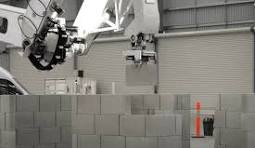Introduction
The future of brick laying in Australia. The recent introduction of robotic bricklaying machines in Australia is a significant development that is reshaping the construction industry. This technological advancement, while it may seem daunting, could also lead to a multitude of opportunities for both the industry and the workforce.
The Robot
Robotic bricklaying machines, such as the Hadrian X, are not just innovative tools; they are revolutionizing the way buildings are constructed. These machines operate autonomously, using advanced sensors and algorithms to ensure precision and accuracy in brick placement. They can lay bricks at an impressive rate of up to 1,000 bricks per hour, far surpassing the capabilities of human bricklayers. This efficiency can significantly reduce construction times and potentially lower costs, making construction projects more viable and profitable.

Intergration
However, the integration of these machines into the industry does not necessarily mean the end of human bricklayers. While these machines can perform the physical task of bricklaying, they cannot replicate the human touch and expertise that goes into the art of bricklaying. Bricklayers bring a level of craftsmanship and attention to detail that is irreplaceable by machines. They can assess the quality of the bricks, make adjustments on the fly, and ensure that the final product meets the highest standards of quality and aesthetics.
Consequences
Moreover, the introduction of these machines does not necessarily equate to job losses for bricklayers. Instead, it could potentially open up new opportunities. Bricklayers might find themselves in roles that involve overseeing the operation of these machines, programming them, or even designing and maintaining them. These roles would require a different set of skills, but they would also provide new avenues for career growth and development.
In addition to this, the presence of robotic bricklaying machines could also lead to an increase in the demand for skilled labour in other areas of construction. As these machines take over the physical task of bricklaying, there might be an increased need for workers who can perform tasks such as planning, design, and project management. This could lead to a more balanced and diversified workforce in the construction industry.
The Brick Layer
The art of hands on craftsman is gradually being erased. Can a robot repoint? Maybe industry members are embracing this kind of technology because robots do not have to join trade unions.

Conclusion
In conclusion, while the emergence of robotic bricklaying machines in Australia is a significant development that could reshape the construction industry, it is not necessarily a cause for alarm. On the contrary, it could be seen as an opportunity for growth and evolution. It may reshape the profession of bricklaying, but it does not necessarily spell doom for human bricklayers. There will always be a need for human expertise, and new opportunities may arise as technology continues to evolve. The future of bricklaying, much like the construction industry as a whole, is likely to be a blend of human skill and technological advancement.